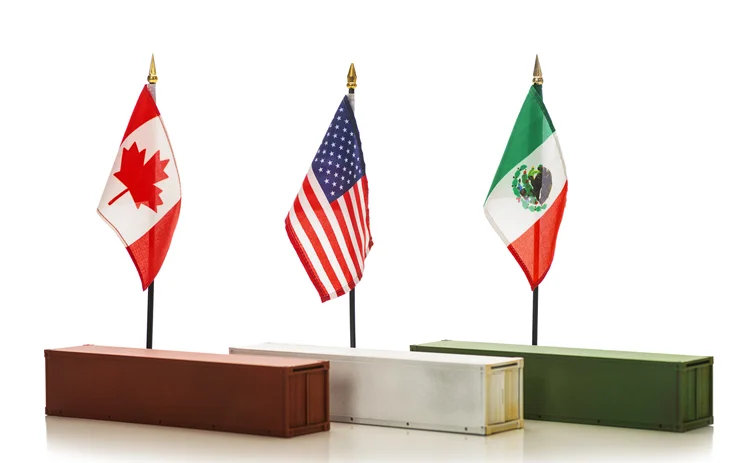All eyes turn to North America as T+1 arrives
As T+1 settlement becomes a reality in North America, long-lingering questions will get their answers.

Need to know
Editor’s note:
The quotes used in this T+1 round-up were taken from the six stories listed below. We highly recommend reading these articles for more information on how the industry got here.
A rough race begins: Industry faces uphill transition to T+1 settlement - WatersTechnology.com (5/23/2023)
Ticking clock: Firms in Asia face unique T+1 challenges - WatersTechnology.com (1/25/2024)
How GenAI could improve T+1 settlement - WatersTechnology.com (2/27/2024)
European firms prime for lopsided settlement in North America and at home - WatersTechnology.com (3/8/2024)
FX dealers face end-of-day trading stress from T+1 shift - Risk.net (4/26/2024)
The wait is over; T+1 settlement is finally here—in North America, anyway.
While switching from T+2 to T+1 settlement is largely a market structure issue, getting to a trade-date-plus-one-day settlement cycle has forced firms to examine the middle- and back-office systems involved in the clearing and settlement process.
About 15 months ago, the US Securities and Exchange Commission announced that May 28, 2024, would be the compliance date for T+1, and Mexico and Canada followed suit. Industry associations from all three jurisdictions has asked for September 3, 2024—Labor Day weekend. In 2017, in the hope of making things easier, the US, Canada, and Mexico moved from T+3 to T+2 during the Labor Day holiday weekend (September 5), which was shared between the US and Canada, as opposed to this past weekend—Memorial Day weekend in the US—which is not a holiday weekend in Canada or Mexico.
That set off a rough race for capital markets firms to get their settlement ecosystems up to snuff in less time than they originally hoped for. Existing legacy systems, manual processes, reduced IT budgets and personnel, and lack of investment in post-trade were just a handful of the perceived roadblocks to achieving shorter settlement cycles. The concern was—and is—that previous changes in settlement involved removing a day from the cycle between trading and settlement, but moving to T+1 means removing what was essentially the only full business day between them.
Post-trade, and in particular clearing and settlement, has not received the budgetary love of, say, artificial intelligence in the front office. “[Post-trade] is sort of the redheaded stepchild. It has been chronically underfunded across the industry,” said Sean Tuffy, an industry commentator and former director of market and regulatory intelligence for securities services at Citi from 2017 to September 2022. He also served 11 years at Brown Brothers Harriman in various roles and spent almost eight years at State Street.
As a result of this underinvestment, according to a survey put out in November 2022 by Torstone and Firebrand Research, 81% of brokers and banks active in North America use either manual processes or homegrown systems to support their post-trade processes. The paper also found that other areas that will need to see changes include corporate actions, physical delivery of securities, and trade confirmation systems.
In the coming months, capital markets firms in North America will show whether they’ve been up to the challenge of preparing for T+1. And the results of those efforts will be closely observed by regulators and industry participants in Europe and Asia to see whether they can learn any lessons, themselves.

Across the pond
Last year, the European Securities and Markets Authority (Esma) issued a call for evidence on shortening settlement cycles and will submit a report to the European Commission in Q4 2024. At a roundtable hosted by the European Commission in January, commissioner Mairead McGuinness told attendees, “When it comes to T+1, the question is no longer if, but how and when it will happen here in the EU.” And in a poll conducted by participants of the same roundtable, 65% of respondents said that they favored a transition in Europe as soon as 2027 or 2028. Meanwhile, the UK government has also assembled an accelerated settlement task force with the aim of exploring a move to shorter settlement windows.
But shortening cycles also poses some significant challenges for European players. Sourcing foreign exchange for US securities purchases is one such difficulty. Matthew Coupe, director for cross-asset market structure at Barclays, told WatersTechnology back in March that most European players currently do the FX leg of a trade on day two of the settlement cycle, allowing them to manage FX demand on the aggregate of their trading positions from the previous day, and settle on T+2.
“That becomes a little bit more challenged in a T+1 environment, because if you’re trying to do it all in one day, you’re having to estimate where you are from an FX perspective while you’re trading the securities. Whenever you compress cycles—whenever you are putting two processes in competition against each other—there will always be inefficiencies and potential mistakes that might come out of that,” he said.
Sachin Mohindra, an executive director at Goldman Sachs who works on the firm’s T+1 strategy in the bank’s client and market solutions division, told WatersTechnology in March that he was “hearing some UK-based clients are moving trading and operations to the US” to address issues in FX trading. “Others are saying, ‘We’re just going to outsource everything to our custodian and get them to do FX on an automated basis.’ There are different solutions out there; none of them are perfect. But these solutions will then help inform how we in Europe and the UK should approach it and what the big obstacles are.”
Beyond FX—but more on that issue in a little bit—asset managers in Europe could be in a particularly tough spot, not just because of issues related to FX settlement, but also because the switch to T+1 in North America will create misalignments in redemptions investments within their own funds.
Fund managers outside the US receive new investments from customers as late as four days after they place their order, meaning that they will have to settle US transactions days before receiving the necessary funds. As a result, many European asset managers are currently grappling with the question of how to fund US trades once the settlement window shrinks in May, Lynn Challenger, global head of trading at UBS Asset Management, told WatersTechnology in March.
“When we receive an order to buy a US stock, we buy it today, pay for it tomorrow, but our clients do not send us the money for two or perhaps three days. We either have to borrow the money from our custodian, allow an overdraft on the account or borrow money from the executing broker by extending settlement. All of those options are going to cost different levels of money and have different levels of availability depending on the size of the trade—but in the end, a client is likely to have to pay more to buy a US stock than they do today,” he said.
In preparation for Europe’s inevitable move to T+1, Goldman Sachs’s Mohindra added that investment in straight-through processing should be a priority in Europe, where there are often more intermediaries and more messages in the chain between allocation and settlement than in the US.
“We’re starting to see golden-source solutions which say, ‘We’ve matched between the buyer and the seller in the trade matching system. Why don’t we take that as the golden match, enrich it with common reference data points, and then send it directly to the CSD? Rather than churning back to the buyer’s and seller’s own systems and the instructions somehow getting misinterpreted and leading to mismatches,’” he said.
Mohindra continued: “If you try to run a marathon when you’ve got an existing injury, all you’re going to do is create more damage. And so trade discrepancies, settlement instructions, reference data and timeliness of instructions, and moving away from batches to real time are all very key.”

And over to Asia
All of the challenges listed above are not exclusive to North America and Europe—firms trading in the Asia-Pacific region will have to clear those hurdles, as well. But there are unique issues that APAC firms will have to address, which could lead to extending working hours to accommodate with the shift, particularly on Friday nights.
Perhaps the greatest challenge facing Asia has to do with pre-funding trades, said a technology and operations specialist with more than 30 years of experience working at buy-side firms.
“If you’ve got to pre-fund and you’re in Asia, you don’t have much time to do that. There’s very little overlap—if any—with the US market, and now, there’s no day grace to solve that problem,” they told WatersTechnology in January.
That aside, though, firms in Asia are already exposed to shorter settlement windows. A head of securities services for Asia-Pacific at a global systemically important bank (G-Sib) told WatersTechnology that Asian investment firms are already used to working with shorter settlement timeframes.
For example, investors participating in the Hong Kong Exchange’s Northbound Stock Connect—which connects Mainland China markets with participants in Hong Kong—must adhere to the Mainland China securities market’s T+0 settlement timeframe.
Additionally, India’s stock markets moved to T+1 in January 2023, and the Securities and Exchange Board of India is already working toward T+0.
Industry sources say that India will prove just as valuable in providing guidance for firms in APAC as watching how North American firms handle the transition. Danny Green, head of international post-trade at Broadridge, told WatersTechnology in January that he sees T+1 as more of a middle-office problem than a “pure” back-office problem. Transaction flows, for example, look at the communicated matching instructions. He said that companies should work with their clients to speed up the allocation process and, finally, agree on a process to deal with FX exposure.
Taking lessons from the T+1 move in India’s market, large fund managers changed their booking models to pre-allocate their trades at the point of booking their orders.
Typically, an order goes to a broker, and once it is filled, the fund manager allocates that trade to the fund or funds they want it to reflect in. “In India, certainly for the large fund managers, they changed their business process and they said, ‘Based on this order, this is how I want the allocations to happen.’ That’s how the large fund managers solved for it in India. When you start thinking about the global markets, that means you need small, medium, and large buy-side clients to adopt that type of process. At present, there’s no indication that they will adopt that process,” he said.

Acronym soup: FX & ESG
Back to the issue of FX, the T+1 transition could lead to increased use of overnight swaps at the end of the US day, putting pressure on FX market-makers to absorb flows at a tricky time for trading and leading to subpar pricing.
Under the current T+2 cycle, foreign investors typically use tomorrow-next FX swaps—where a currency is simultaneously bought and sold over two separate business days—to fund the purchase or sale of securities. This is also transacted after the equities trade is matched, affirmed, and confirmed. However, in the T+1 framework, the timeframe to fund and transact the FX-related trade becomes shortened. As a result, investors may have to turn to overnight FX swaps—a swap traded the same day and settled tomorrow—to obtain the US dollars needed for the securities trade. Furthermore, market-makers could struggle to handle the influx of overnight FX swaps trades and keep their risk flat, especially when they are being transacted later in the day.
“With a greater need for overnight FX swaps, especially later in the day at a time when the market-makers themselves may not have the inventory to absorb this new flow, then I would expect that to be quite problematic,” said Paul Matherne, the former global head of FX trading and head of markets for Europe, the Middle East and Africa at BNY Mellon. Matherne was speaking on a webinar hosted by WatersTechnology sibling publication FX Markets on April 24.
As Goldman Sachs’ Mohindra noted earlier, straight-through processing will be key, Matherne said. “Automation is certainly the real answer here. Because what’s happening is the timeline for everything that occurs between trading and settlement is being compressed, which means the only way really to do this correctly and reliably in scale is to use STP.”
Lisa Danino-Lewis, chief growth officer at CLS, concurred: “The more straight-through processing [STP] you have, and the more automated your processes are, the more efficient you can be—even on the bilateral settlement piece.”
Beyond FX, the world of exchange-traded funds, where global trading volumes reached nearly $45 trillion in 2023, could experience unintended consequences as a result of North America ticking over to T+1 settlement.
ETFs comprise a basket of underlying securities, often from several jurisdictions. Settlement delays already happen in a T+2 environment due to time zone differences, market holidays, and cross-border settlement complexity. These challenges, according to the Association for Financial Markets in Europe, would be even more pronounced in a T+1 environment.
Peggy Vena, head of ETF services at Citi Securities Services, told WatersTechnology last month that the biggest challenge overall is the various vendor ETF portals in the market. Citi has ACES—the Advanced Citi ETF System, its online, global ETF portal that automates the entire ETF process—and other custodians also have their own portals, she said. From the perspective of an authorized participant (AP)—typically a bank that manages the creation and redemption of ETFs—processing create or redeem orders requires traders to log into a multitude of portals.
It is this “creation” and “redemption” process that allows ETFs to trade on exchanges like individual stocks. Creation involves buying the underlying securities and wrapping them into the ETF structure, while redemption is where the ETF is then unwrapped into the individual securities. The APs work with ETF issuers—otherwise known as ETF sponsors—who create and launch ETFs, to manage the creation and redemption process.
“When I talk to our Markets colleagues who are authorized participants—they actually sit on the other side of the floor—they all have multiple electronic tokens for all the different portals because they have to log into different portals to trade different ETFs, and it quite frankly is just time consuming and inefficient,” she said.
Gerard Walsh, global head of capital markets clients solutions at Northern Trust, told WatersTechnology that the capital markets need to reimagine the entire trade lifecycle for the impacted assets, which include ETFs, stocks, bonds, municipal securities, and certain mutual funds.
But there’s another reason—and another cost—resulting from the move to T+1 that could require firms to make cash available early to coordinate differing settlement cycles. With thousands of ETFs listed in the US subject to T+1 settlement but containing foreign underlying securities subject to different settlement schedules, Walsh said a misalignment in terms of settlement cycles could emerge.
For example, if an ETF listed on the New York Stock Exchange invests in emerging markets in Asia-Pacific, many of the underlying components of that ETF will be on T+2 and T+3 settlement cycles.
Walsh explained that if the firm is selling an ETF, it’ll be expecting to receive the funds for the ETF itself into the fund or portfolio. But, due to the misalignments in settlement cycles, the other underlying components will mean the firm has got more cash in the fund than it expected to have.
“It’s something managers will need to monitor very closely in case they end up with more cash than they need, or need to use an overdraft to ask for liquidity in ways they didn’t think to ask before if they’re on the buy side of an ETF trade. And if they’re buying something, they’ll need access to liquidity over a multi-day period. So they need more cash at the front end of that trade than they would expect to deploy. Because in the old days, you’d wait until the last component of the underlying components was ready to settle,” he said.

AI: savior or false prophet?
Post-trade, as noted before, has been chronically underfunded. There are some who believe that this is why blockchain experimentation became so popular a decade ago—budgets were freed up for this technology that underpinned bitcoin. Unfortunately, a decade later, the shine around blockchain and distributed-ledger technology (DLT) in the capital markets has dulled significantly.
But a different emerging technology is offering hope for solving at least some settlement transition woes—generative AI.
Broadridge’s Green noted that the clearing and settlement technology giant has developed a tool called OpsGPT, with the GPT short for Generative Pre-trained Transformer. He explained that Broadridge continues to work on reducing any friction within operations and processing, and OpsGPT, which the firm launched on January 12, is one result of that.
OpsGPT uses GenAI and large language model (LLM) technology to provide ops users, analysts, and management teams with information based on transactions, settlements, and positions data. It also provides real-time visibility for fail resolution, next-best actions, and prioritizing risk items.
For example, it enables Broadridge’s clients to ask for: “All my unmatched trades that need to be solved in the next 60 minutes.” Then, the user can also ask to sort those results, say, by value.
“As an operations user, you spend a lot of time working through the data to understand where your problems are in order to then go, ‘OK, these are the things that I need to work on or [that] I need to fix.’ What OpsGPT does—in a very natural way—is present the kind of things you need to be looking at, and in addition to that, once you’re using it as an organization, it continues to learn,” he said.
Meanwhile, IBM is also exploring ways to use GenAI to make T+1 settlement more efficient.
Researchers at the tech behemoth are exploring how LLMs built from carefully curated data, which are then fine-tuned to address a particular task, can be used to help with compliance checks and predicting when affirmations will fail in collaboration with traditional machine learning-based failure prediction models. If, for example, an LLM can make that prediction sufficiently in advance of 9:00 pm on T+1, firms will have an opportunity to address the failure and prevent it from occurring.
The researchers told WatersTechnology in February that GenAI can also assist with additional steps in the settlement cycle. Using a unified interface, investment managers can give clients real-time visibility into their investments’ status, research the best course of action, prioritize critical risk items, and provide an allocation progress report, among other things.
Another area where GenAI might be helpful is automating communication among several parties. Generative modeling, such as Generative Adversarial Networks (GANs), can also help handle exceptions during settlement. Improving resolution workflows, it finds anomalies independently and sorts them by impact, urgency, or severity. This method shortens the resolution time and reduces the likelihood of settlement failures caused by unresolved exceptions by making intelligent suggestions.
Perhaps it’s ironic that a technology that could pull budgetary dollars away from fixing traditional post-trade issues could also be a savior for the post-trade space. But, then again, the same was said of DLT, and while proponents still exist, there aren’t as many as before.
Further reading
Only users who have a paid subscription or are part of a corporate subscription are able to print or copy content.
To access these options, along with all other subscription benefits, please contact info@waterstechnology.com or view our subscription options here: http://subscriptions.waterstechnology.com/subscribe
You are currently unable to print this content. Please contact info@waterstechnology.com to find out more.
You are currently unable to copy this content. Please contact info@waterstechnology.com to find out more.
Copyright Infopro Digital Limited. All rights reserved.
As outlined in our terms and conditions, https://www.infopro-digital.com/terms-and-conditions/subscriptions/ (point 2.4), printing is limited to a single copy.
If you would like to purchase additional rights please email info@waterstechnology.com
Copyright Infopro Digital Limited. All rights reserved.
You may share this content using our article tools. As outlined in our terms and conditions, https://www.infopro-digital.com/terms-and-conditions/subscriptions/ (clause 2.4), an Authorised User may only make one copy of the materials for their own personal use. You must also comply with the restrictions in clause 2.5.
If you would like to purchase additional rights please email info@waterstechnology.com
More on Trading Tech
Recent volatility highlights tech’s vital role in fixed income pricing
MarketAxess’ Julien Alexandre discusses how cutting-edge technology is transforming pricing and execution in the fixed income market amid periodic bouts of volatility
Banks fret over vendor contracts as Dora deadline looms
Thousands of vendor contracts will need repapering to comply with EU’s new digital resilience rules
Where have all the exchange platform providers gone?
The IMD Wrap: Running an exchange is a profitable business. The margins on market data sales alone can be staggering. And since every exchange needs a reliable and efficient exchange technology stack, Max asks why more vendors aren’t diving into this space.
This Week: Trading Technologies completes ANS deal; State Street; Equinix; and more
A summary of the latest financial technology news.
Interactive Brokers looks beyond US borders for growth opportunities
As retail trading has grown in volume and importance, Interactive Brokers and others are expanding international offerings and marketing abroad.
JP Morgan’s goal of STP in loans materializes on Versana’s platform
The accomplishment highlights the budding digitization of private credit, though it’s still a long road ahead.
As data volumes explode, expect more outages
Waters Wrap: At least for those unprepared—though preparation is no easy task—says Anthony.
This Week: ICE Bonds and MarketAxess plan to connect liquidity networks, TS Imagine, Bloomberg, and more
A summary of the latest financial technology news.







